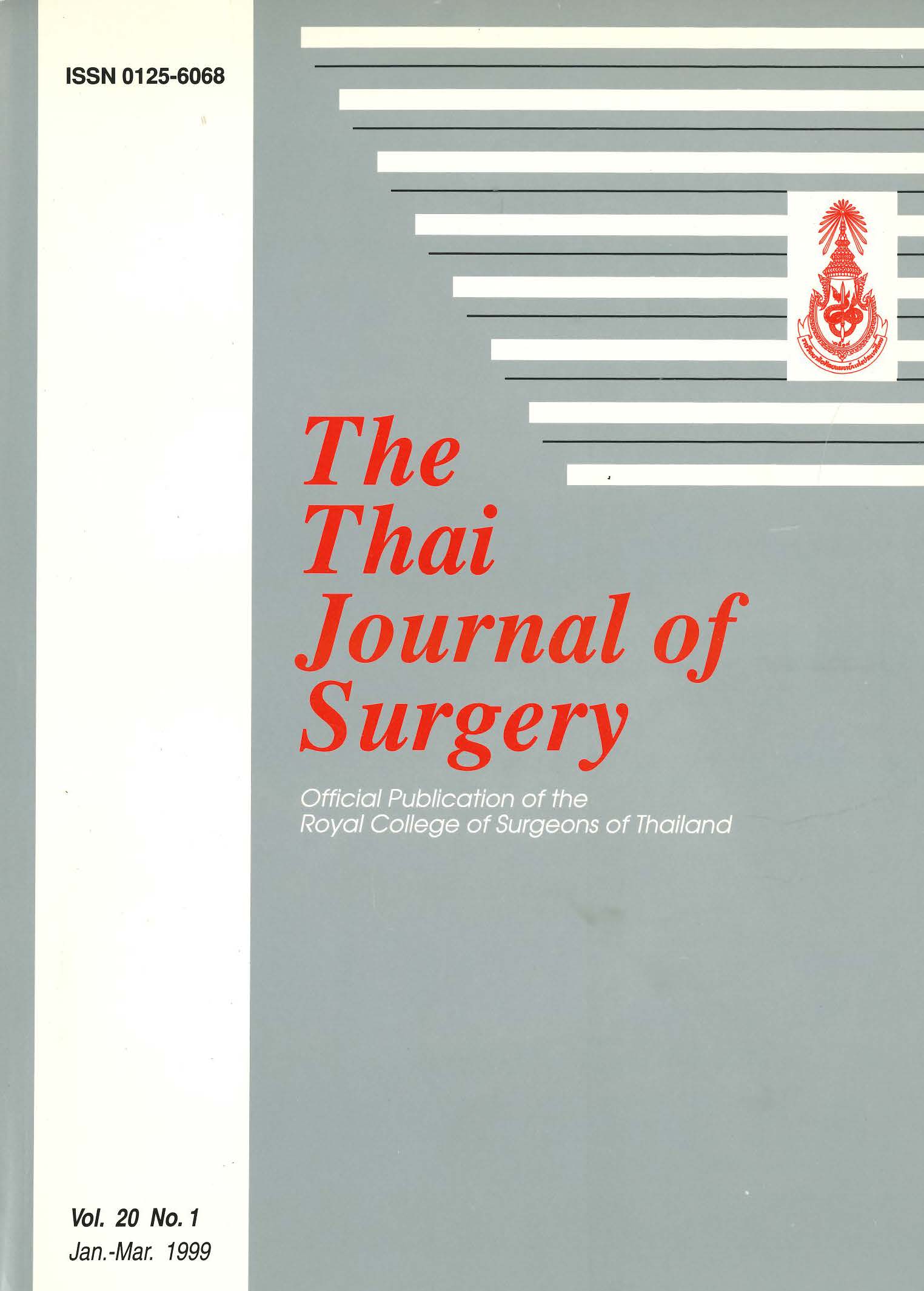Laser Lithotripsy of Difficult Bile Duct Stones Under an Integrated Automatic Stone-Tissue Detection System
Abstract
We report our preliminary experience in the treatment of 16 CBD stone patients with a combination of ERCP with EST and rhodamine-6G dye laser (wavelength 595 nm) with an integra ted automatic stone-tissue detection system. More than half (56.2%) of the patients had previous abdominal operations, whereas 37.5% had choledochotomy. Laser fibers were controlled by fluoroscopy only (blind technique). The laser energies used were 80-120 m] and 5-8 Hz frequency. The sizes of stone ranged from 1.5 to 4.5 cm with an average of 2.7t1.0 cm. Laser lithotripsy resulted in successful fragmentation of stones in 14 of l6 patients (87.5%).
In case of severe acute cholangitis (25%), temporary drainage by endoprosthesis in the CBD and appropriate adjunct therapeutic measures were used. After the infection subsided, usually one week, definitive laser treatment was then performed. The 30-day mortality rate was zero. We conclude that laser lithotripsy is an effective and safe treatment in a highly selected patient of difficult bile duct stones with considerable surgical risk.
References
2. Neuhaus H, Hoffmann W, Classen M. Laser lithotripsy of pancreatic and biliary stones via 3.4 and 3.7 mm. Miniscopes: First clinical results. Endoscopy 1992; 24 : 208-14.
3. Classen M, Hagenmuller F, Knyrim K, Frimberger E. Giant bile duct stones, non surgical treatment. Endoscopy 1988;20:21-6.
4. Neoptolemos JP, Hofman AF, Moua AR. Chemical treatment of stones in the biliary tree. Br J Surg 1986; 73:515-24.
5.Koch H, stolte M, Walz U. Endoscopic lithotripsy in the common bile duct. Endoscopy 1977: 9:95-8.
6. Sauerbruch T, Holl J, Sackmann M, et al. Treatment of bile duct stones by extracorporeal shock waves. Semin. Ultra-sound CT MR 1987: 8:155-61.
7. Sauerbruch T, Holl J, Sackmann M, et al. Disintegration of a pancreatic duct stone with extracorporeal shock waves in apatient with chronic pancreatitis, Endoscopy1987;19:207-
8. MoLR, Hwang MH, Yueh SK, et al. Percutaneous transhepatic choledochoscopic electrohydraulic lithotripsy (PTCS-EHL) of common bile duct stones. Gastrointest Endosc 1988;34:122-5.
9. EllCH, Wondrazek F, FrankF, et al. Laser-induced shockwave lithotripsy of gallstones. Endoscopy 1986; 18:95-6.
10. Kozarek RA, Low DE, Ball TJ, Tunable dye Laser lithotripsy: in vitro study and in vivo treatment of choledocholithiasis. Gastrointest Endosc 1988: 5:418-21.
11. Cotton PB, Kozarek RA, Schapiro RH, et al. Endoscopic laser lithotripsy of large bile duct stones, Gastroenterology 1990;99:1128-33.
12. Ponchon T, Gagnon P, Valette PJ, Henry L, et al. Pulsed dye laser lithotripsy of bile duct stones. Gastroenterology 1991: 100:1730-6.
13. Ell C, HochbergerJ, Muller D,Zirngibl H, et al. Laser lithotripsy of gallstones by means of a pulsed neodymium YAG laser : in vitro and animal experiments. Endoscopy 1986; 18:92-4.
14. Gagnon P, Ponchon T, Naouri A. Berger F, Effects of pulsed dye laser on the biliary wall of the dog. Abstract DDW Texas, San Antonio 1991: A 1542.
15. Nishioka N, Kelsey P, Kibbi A, Delmonico F, et al. Laser lithotripsy: animal studies of safety and efficacy, Lasers Surg Med 1988:8:357-63.
16.Ell CH, Hochberger J, May A, Fleig WE, et al. Laser lilhotripsy for difficult bile duct stones by means of a rhodamine-6G laser and an integrated automatic stone-tissue detection system. Gastrointest Endosc 1993; 39:755-62.
17. Hochberger J, Wittekind C,lro H, Mendez L, et al. Automatic stone/tissue detection system for dye laser lithotripsy of gallstones: in vivo experiments (Abstract). Gastroenterology 1992;102:A315.
18. Hochberger J, Bredt M, Muller G, Hahn EG, et al. Laser lithotripsy of gallstones: alexandrite and rhodamine-6G versus coumarin dye laser: fragmentation and fiber burn off in vitro. Society of Photo-Optical Instrumentation Engineers Proceedings,vol. 1879 (code No. 1879-29) Bellingham, Wash,1993.
19. Lux G, Ell C, Hochberger J, et al. The first endoscopic retrograde lithotripsy of common bile duct stones in man using a pulsed neodynium YAG laser. Endoscopy 1986; 18:144-5
20. Nishioka N, Le vins P, Murray S, Parrish J, et al. Fragmentation of biliary calculi with tunable dye lasers. Gastroenterology 1987:93:250-5.
21. Neuhaus H, Hoffmann W, Zillinger C, Classen M. Laser lithotripsy of difficult bile duct stones under direct visual control. Gut 1993: 34: 415-21.
22. Sauerbruch T, Stem M. Study Group for Shock-wave Lithot-ripsy of Bile Duct Stones. Fragmentation of bile duct stones by extracorporeal shock-waves. A new approach to biliary calculi after failure of routine endoscopic measures. Gastroenterology 1989: 96:146-52.
23. Ponchon T, Chavaillon A, Ayela P, Lambert R. Retrograde biliary ultrathin endoscopy enhances biopsy of stenosis and lithotripsy. Gastrointest Endosc 1989; 35:292-7. Escourrou J, Buscail L, Delvaux M, Frexinos J, et al. Peroral choledochoscopy : indications and results in 21 patients with biliary stones (abstr). Gastrointest Endosc 1989; 35:164.
24. Leung JWC, Chung ssc. Electrohydraulic lithotripsy with peroral choledochoscopy. Br Med J 1989:299:595-8.
25. Mo LR, Hwang MH, Yeun Sk, Yang JC, et al. Percutaneous transhepatic choledochoscopicelectrohydrauliclithotripsy of common bile duct stones. Gastrointest Endosc 1988; 34:122-5.
26. Sievert CE, Silvis SE. Evaluation of electrohydraulic lithotripsy as a means of gallstone fragmentation in a canine model. Gastrointest Endosc 1987: 33:233-5.
Downloads
Published
How to Cite
Issue
Section
License
Articles must be contributed solely to The Thai Journal of Surgery and when published become the property of the Royal College of Surgeons of Thailand. The Royal College of Surgeons of Thailand reserves copyright on all published materials and such materials may not be reproduced in any form without the written permission.



